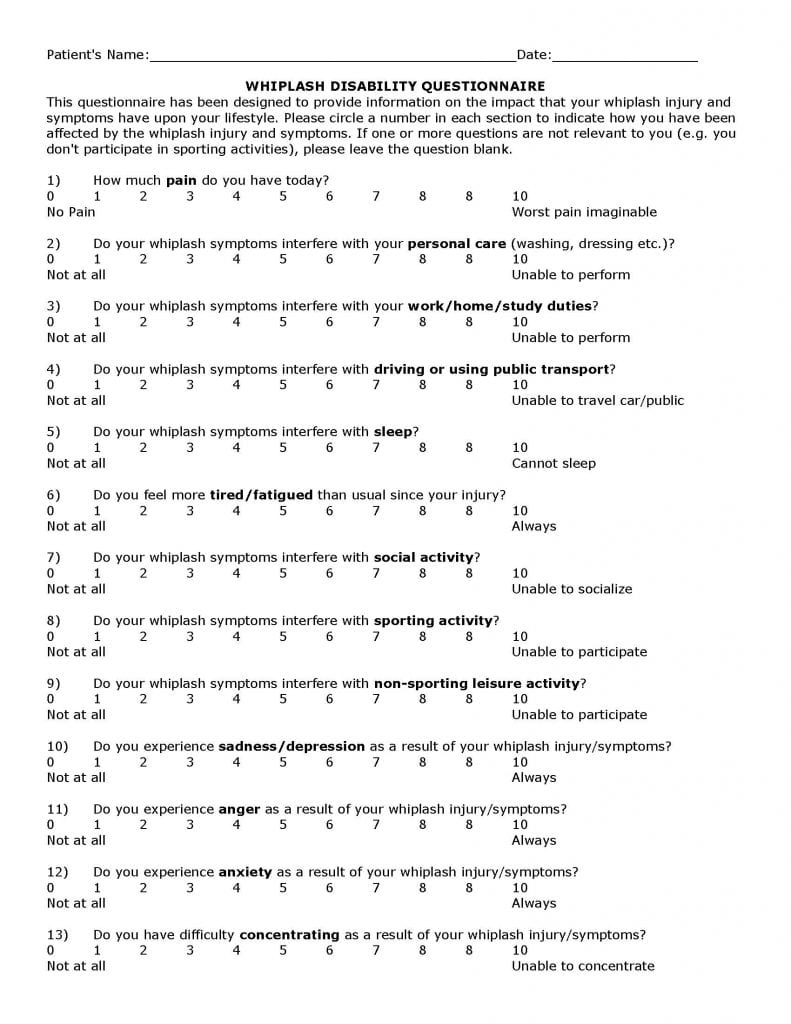'Comparison of the Neck Disability Index and the Neck Bournemouth Questionnaire in a sample of patients with chronic uncomplicated neck pain.' J Manipulative Physiol Ther 30(4): 259-262. Find it on PubMed. Hogg-Johnson, S. 'Differences in reported psychometric properties of the Neck Disability Index: patient population or choice of. Neck Index Score Title: Microsoft Word - Spanish NDI v.2.doc Author: Hcoffey Created Date: 2/22/2006 3:37:41 PM.
How does the neck disability index (NDI) calculator work?
Neck Index ACN Group, Inc. Use Only rev 3/27/2003 Patient Name Date This questionnaire will give your provider information about how your neck condition affects your everyday life. Please answer every section by marking the one statement that applies to you. If two or more statements in one. Neck%20Index11-3-05.pdf Author: Craiche. Index Score = Sum of all statements selected / (# of sections with a statement selected x 5) x 100 Neck Index Score Title: Microsoft Word - Spanish NDI v.2.doc Author: Hcoffey Created Date.
This is a health tool that evaluates the effect cervical spine neck pain has had on the subject in terms of lifestyle day to day activities.
The NDI is based upon the Oswestry Low Back Pain Disability Index and is a self report condition specific questionnaire. The 10 items addressing functional status are listed below.
■ Pain Intensity - pain occurrence and perceived severity;
■ Personal Care (Washing, Dressing etc.) – ability to care for oneself and degree of perceived accuracy in doing so;

■ Lifting – capacity to lift different weights and pain occurrence while doing so;
■ Reading – degree of experienced pain in the neck during and in different reading positions;
■ Headache – frequency and perceived severity of recurrent headaches;
■ Concentration – degree of difficulty in concentration;
■ Work – comparison between past and actual work capacity;
■ Driving – ability to drive and length of time to drive before pain starts;
■ Sleeping – quantifies sleep disturbance in terms of time;
■ Recreation – perceived impairment to partaking in leisure activities.
Each of them comprises of 5 answer choices, varying in severity of pain or degree of movement, activity impairment from A to F. Therefore choice A carries 0 points while question F weighs 5 points.
Nowadays the neck disability index is one of the most used measures for neck pain and has been translated in several languages. Going through the questionnaire should take between 2 to 9 minutes with mean duration values in the studies placed between 3 and 7.8 minutes.
After the original study in 1991, several validation studies have ensued with different reliability outcomes.
The neck disability index (NDI) calculator can be used to evaluate current status but also to monitor disability evolution or response to treatment. Current recommendation suggest the tool to be used at baseline and then fortnightly for monitoring purposes.
However, it appears that a change of at least 5 points in most conditions or 10 in mechanical neck pain and 13 in cervical radiculopathy, can be recognized as clinically meaningful. During recovery patients usually score between 5 to 20 overall in the disability status.
The NDI testing resulted in a fair to moderate test-retest reliability in patients with mechanical neck pain but also for patients with cervical radiculopathy .
Also the following populations have been tested:
■ Cervical radiculopathy;
■ Neck pain: Chronic, non-specific;
■ Neck pain: Chronic, non-traumatic;
■ Neck pain: Chronic, uncomplicated;
■ Neck pain: Degenerative, post-traumatic and other;
■ Neck pain: Mechanical;
■ Neck pain: With or without arm pain.
Therefore the tool is seen as valid in evaluating neck pain and outcomes in patients with either acute or chronic conditions, whiplash associated conditions as well as musculoskeletal dysfunctions.
NDI score interpretation
As explained above, each of the 10 items consists of 5 answer choices with points from 0 to 5. This means that the overall score range is between 0 and 50, 0 being no to little pain and discomfort while 50 being the severest degree of pain and disability with complete activity limitation.
The score is sometimes expressed in percentage as well. The higher the score, the higher the perceived impairment in this disability rating scale for neck injuries.
Although the original study does not provide specific benchmarks or cut off points, there are several interpretations available, although not completely validated, such as that of Vernon and Moir, described below:
■ 0-4 points (0-8%) no disability;
■ 5-14 points ( 10 – 28%) mild disability;
■15-24 points (30-48% ) moderate disability;
■ 25-34 points (50- 64%) severe disability;
■ 35-50 points (70-100%) complete disability.
References
1) Vernon H, Mior S. (1991) The Neck Disability Index: a study of reliability and validity. J Manipulative Physiol Ther; 14(7):409-15.
2) Cleland JA, Childs JD, Whitman JM. (2008) Psychometric properties of the Neck Disability Index and Numeric Pain Rating Scale in patients with mechanical neck pain. Arch Phys Med Rehabil; 89(1):69-74.
3) Cleland JA, Fritz JM, Whitman JM, Palmer JA. (2006) The reliability and construct validity of the Neck Disability Index and patient specific functional scale in patients with cervical radiculopathy. Spine (Phila Pa 1976); 31(5):598-602.
4) Hogg-Johnson S. (2009) Differences in reported psychometric properties of the Neck Disability Index: patient population or choice of methods? Spine J; 9(10):854-6.
18 Jan, 2016Vernon H; Mior S
Distributed by Mapi Research Trust
Basic description
- Developed in the late 1980’s
WEBINAR: An Author Webinar on the Neck Disability Index - Recorded session available here!
The NDI is a revised form of the Oswestry Low Back Pain Index
Vernon H; Mior S
- Pathological Conditions, Signs and Symptoms
Neck Pain
- PRO
- English for North America
Vernon H, Mior S. The Neck Disability Index: a study of reliability and validity. J Manipulative Physiol Ther. 1991 Sep;14(7):409-15. Erratum in: J Manipulative Physiol Ther 1992 Jan;15(1) (PubMed abstract)
Access this questionnaire
Please log in or sign up for free
Login SIGN up freeContact and conditions of use
Authors
Vernon H; Mior S
Dr Howard Vernon
Division of Research
Director, Centre for the Study of the Cervical Spine
Canadian Memorial Chiropractic College
6100 Leslie Street
Toronto, Ontario
M2H 3J1
Canada
Phone: +1 (416) 482-2340, ext. 216
Fax: +1 (416) 482-1696
E-mail: hvernon3484@gmail.com
Contact information
Mapi Research Trust
PROVIDE™
27 rue de la Villette
69003 Lyon
France
Phone: +33 (0)4 72 13 66 66
Conditions of use
Students, physicians, clinical practice, not-funded academic users
You may access available translations of the questionnaire directly (see tutorial). Should you not see the Download button, please contact us.
Funded academic users, healthcare organizations, commercial users & IT companies
Fees may apply to your project. Submit your request (see tutorial). Our PROVIDE team will get back to you with the needed information and license agreement in a timely manner.
Review copy
Examination copies can only be used for the limited purpose of examining the suitability of the Questionnaire for subsequent research and/or clinical use, and cannot be used in research or in clinical practice or distributed to others.
You are not authorized to modify, retype, translate, copy or otherwise duplicate the Questionnaire except with the further and prior written permission of Mapi Research Trust / the developers / copyright holders / distributors.
Languages
Original language(s)
- English for North America
Translations
The list of available translations is subject to constant changes and may not be exhaustive. It is provided for information only. Some recently produced translations may not be included in the list below yet. Please do check the status of available translations with Mapi Research Trust / the developers / copyright holders / distributors.
Also, the listed translations may not have undergone a full linguistic validation process and may require further work to be suitable for use in a study.
Bengali for Bangladesh
Catalan for Spain
Danish for Denmark*
Dutch for Belgium (Flemish)*
Dutch for the Netherlands*
English for Australia*
English for Canada*
English for the UK*
English for the USA*
French for France*
French for Switzerland*
German for Switzerland*
Iranian
Italian for Italy*
Korean for Korea
Malay for Singapore
Mandarin for Taiwan
Norwegian for Norway*
Portuguese for Portugal*
Spanish for Spain*
Spanish for the USA*
Swedish for Sweden*
Turkish for Turkey
Ukrainian for Ukraine
Urdu for Pakistan
BiblioPRO: you can find information about the Spanish version here - puede encontrar información sobre la versión española aqui
The author has selected Mapi/ICON Language Services as exclusive linguistic validation company to ensure the production of harmonized and consistent language versions.
For additional information on available translations of this instrument, or for a project involving new languages, please submit a request (tutorials available on our FAQs).
Conditions to translate
Academic Translation
If you wish to translate the questionnaire:
- Log in or Register for free
- Submit your request for translation online (Tutorials are available on our FAQs)
- Our PROVIDE team will send you a translation agreement along with Linguistic Validation Guidelines.
Commercial Users
Neck Disability Index Questionnaire

Exclusive vendor for translation work for commercial users: Mapi/ICON Language Services
More information on translations
Some of the translations performed by Mapi have been based on version 1.0 of the NDI and need to be updated in order to be used. Please check the status of translations with Mapi Research Trust.
Copy of the Catalan version: NDI in Catalan
Bibliographic references of the translations:
Catalan:
Nieto R, Miró J, Huguet A. Disability in subacute whiplash patients: usefulness of the neck disability index. Spine. 2008 Aug 15;33(18):E630-5
Chinese:
Wu S, Ma C, Mai M, Li G. Translation and validation study of Chinese versions of the neck disability index and the neck pain and disability scale. Spine (Phila Pa 1976). 2010 Jul 15;35(16):1575-9 (PubMed abstract)
Dutch:
Vos CJ, Verhagen AP, Koes BW. Reliability and responsiveness of the Dutch version of the Neck Disability Index in patients with acute neck pain in general practice. Eur Spine J. 2006 Nov;15(11):1729-36. Epub 2006 May 3
French:
Wlodyka-Demaille S, Poiraudeau S, Catanzariti JF, Rannou F, Fermanian J, Revel M. French translation and validation of 3 functional disability scales for neck pain. Arch Phys Med Rehabil. 2002 Mar;83(3):376-82
Iranian:
Mousavi SJ, Parnianpour M, Montazeri A, Mehdian H, Karimi A, Abedi M, Ashtiani AA, Mobini B, Hadian MR. Translation and validation study of the Iranian versions of the Neck Disability Index and the Neck Pain and Disability Scale. Spine. 2007 Dec 15;32(26):E825-31
Korean:
Lee H, Nicholson LL, Adams RD, Maher CG, Halaki M, Bae SS. Development and psychometric testing of Korean language versions of 4 neck pain and disability questionnaires. Spine. 2006 Jul 15;31(16):1841-5
Malay:
Lim HHR, Tan ST, Tang ZY, Yang M, Koh EYL, Koh KH. Cross-cultural adaptation and psychometric evaluation of the Malay version of the Neck Disability Index. Disabil Rehabil. 2020 May 6:1-7 (PubMed abstract)
Neck Disability Index Spanish Pdf
Spanish:
Kovacs FM, Bagó J, Royuela A, Seco J, Giménez S, Muriel A, et al. Psychometric characteristics of the Spanish version of instruments to measure neck pain disability. Musculoskelet Disord. 2008 Apr 9;9:42
Oswestry Disability Index Spanish Pdf
Andrade Ortega JA, Delgado Martínez AD, Almécija Ruiz R. [Validation of a Spanish version of the Neck Disability Index] Med Clin (Barc). 2008 Feb 2;130(3):85-9. Spanish
Neck Index In Spanish Printable
Turkish:
Aslan E, Karaduman A, Yakut Y, Aras B, Simsek IE, Yaglý N. The cultural adaptation, reliability and validity of neck disability index in patients with neck pain: a Turkish version study. Spine. 2008 May 15;33(11):E362-5
E-versions
Conditions to implement in electronic applications
Spanish Ndi Pdf
Please refer to the 'Contact and conditions of use' tab
Member Access
Subscribe to PROQOLID to access to full information
Access to advanced descriptions of Clinical Outcome Assessments (COAs)
A question? Contact us